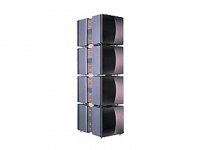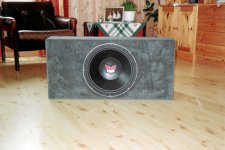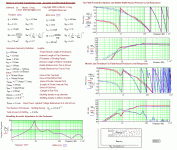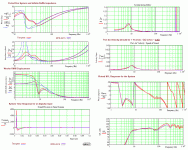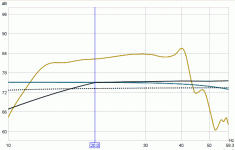Apology?
Harrumph!
All you've got to do is look at the video. Simple eyeball inspection clearly shows that he's got stuff in the ports. Anyone can increase port velocity in a bass reflex cabinet by decreasing the amount of area available for the air to enter/exit the interior of the cabinet. After that, it's a simple case of Bernoulli's Principle. You know...that stuff they talked about in science class. Jeez, what do they teach in schools these days?
I'm not saying that it isn't loud, just that it's a parlor trick. You're not going to want to listen to music that way--you've just changed the parameters of the port(s) and the (hopefully) flat response goes out the window.
Grey
Harrumph!
All you've got to do is look at the video. Simple eyeball inspection clearly shows that he's got stuff in the ports. Anyone can increase port velocity in a bass reflex cabinet by decreasing the amount of area available for the air to enter/exit the interior of the cabinet. After that, it's a simple case of Bernoulli's Principle. You know...that stuff they talked about in science class. Jeez, what do they teach in schools these days?
I'm not saying that it isn't loud, just that it's a parlor trick. You're not going to want to listen to music that way--you've just changed the parameters of the port(s) and the (hopefully) flat response goes out the window.
Grey
FE3T,
There must be a reason that the closed box is recommended (as you said about the 12) and I doubt it would just be due to simplicity. Sure, none but a very few would recommend a horn enclosure as standard due to complexity, but in this case the manufacturer may feel that the reflex would offer too much bass (in an average room).
Have you considered room gain? Drivers like these wouldn't have to try hard to meet the room to get a flat response.
There must be a reason that the closed box is recommended (as you said about the 12) and I doubt it would just be due to simplicity. Sure, none but a very few would recommend a horn enclosure as standard due to complexity, but in this case the manufacturer may feel that the reflex would offer too much bass (in an average room).
Have you considered room gain? Drivers like these wouldn't have to try hard to meet the room to get a flat response.
I've read a couple threads about building a set of stackable sealed bass boxes which would provide the flexibility to create a monopole, dipole, bipole or cardiod linesource woofer array using a control box which provided equalization and delay(cardiod).
15" woofers have worked best for me...relatively light treated paper cone, Faraday ring motor, medium 15mm Xmax, Qrc ~ 0.38
15" woofers have worked best for me...relatively light treated paper cone, Faraday ring motor, medium 15mm Xmax, Qrc ~ 0.38
Attachments
lndm said:FE3T,
There must be a reason that the closed box is recommended (as you said about the 12) and I doubt it would just be due to simplicity. Sure, none but a very few would recommend a horn enclosure as standard due to complexity, but in this case the manufacturer may feel that the reflex would offer too much bass (in an average room).
Have you considered room gain? Drivers like these wouldn't have to try hard to meet the room to get a flat response.
Actually, Rockford Fosgate does recommend the following volumes for these woofers for use in cars .
And i suspect that both the acoustic proporsions of a usual car and the need to keep sizes down have influensed these recommendations
RFR 2212 Sealed 35,4L about qcb 0,7
RFR 2212 Ported 56,6L tuned to 35 hz
RFR 2215 Sealed 71L about qcb 0,7
RFR 2215 Ported 71L tuned to 35 hz
Link to user manual
http://www.rockfordfosgate.com/rftech/library/1999/5_Subwoofers/LIT10226_PowerDVC_MAN.pdf
With my limited experience i atleast belive that the ported examples are not optimal in a living room due to a lift in the 40-50hz region and a rapid rolloff below that, so i tried the sealed version with the 12`s wich atleast to my software seems to be relatively flat down to 45hz with a soft fall from there.
(i had also easy access to enclosures of the recommended size for the 12`s)
Sealed for the 15`s are not out of the question, but i belive i would use larger enclosures in a home both than whats recommended for car use.
Examples
Sealed 100-150L qcb 0,62-0,55. -3db at 41-43 hz -10db at 20hz
Ported 160L, tuned at 23 hz . - 3db at 25hz. -7db at 20 hz
I did at one time test my car enclosure wich uses exact the same RF 15" indoors , and it shurely slammed but i did sound a bit "fat" in my livingroom (the recommended 71L sealed box)
So thats one of the reasons why i feel the need for a larger sealed or ported enclosure
Attachments
Hi FE3T,
Look what’s possible if bigger =(160 x 70 x 60 (cm) L, W, D,) DBR enclosure volume is allowed for the 15” RFR 2215 in comparison with Adire’s Tempest:
1(2)
b
but i am very curious about how the 15`s vould do in a pair larger ported boxes
Sealed for the 15`s are not out of the question, but i belive i would use larger enclosures in a home both than whats recommended for car use.
Look what’s possible if bigger =(160 x 70 x 60 (cm) L, W, D,) DBR enclosure volume is allowed for the 15” RFR 2215 in comparison with Adire’s Tempest:
1(2)
b
Attachments
Originally posted by bjorno
I am sertanly no expert at reading such chemes but the parts i did understand looked impressing to me.
If i got things close to rigth it looked that atleast in theory i could expect -6d/oct dropoff from 40hz with this enclosure.
But since some of the stuff in these pictures got a bit over my head i have a few questions
1. To me it seems like the specs used for the Tempest are a 2x8ohm DVC with the coils in paralell and The RFR 2215 a 2x4ohm (wich is correct) with Coils in Series. Shouldnt the RE for the RFR then be 7,2ohm instead of the 3,6ohm you used? (does this even matter for the simulation?)
2. On the first pic its shown a crude drawing of the enclosure and a lot of numbers showing the different dimensions.
Sadly enough are my monitor close enough to its end (or maybe i need glasses) that im not able to read everything in the pics.
Anyone helpfull enough to come up with a easy to understand drawing showing the measurements?

Regards Arne
Hi Arne,
Yes but you should look at the plot: Plotted SPL Response for the System.
Maybe this picture will be of some help: See submitted pdf. Or visit http://www.quarter-wave.com/
The Tempests is in parallel but for the RFR 2215 is only one coil used.
b
1(1)
If i got things close to rigth it looked that atleast in theory i could expect -6d/oct dropoff from 40hz with this enclosure.
Yes but you should look at the plot: Plotted SPL Response for the System.
On the first pic its shown a crude drawing of the enclosure and a lot of numbers showing the different dimensions
Maybe this picture will be of some help: See submitted pdf. Or visit http://www.quarter-wave.com/
To me it seems like the specs used for the Tempest are a 2x8ohm DVC with the coils in paralell and The RFR 2215 a 2x4ohm (wich is correct) with Coils in Series. Shouldnt the RE for the RFR then be 7,2ohm instead of the 3,6ohm you used? (does this even matter for the simulation?)
The Tempests is in parallel but for the RFR 2215 is only one coil used.
b
1(1)
Attachments
OK, you may lose some cabin gain when you move to your living room and the lowest bass may be less loud. The tone might still be good. After all, boosting bass beyond flat is sometimes wanted in a car environment.FE3T said:...i suspect that both the acoustic proporsions of a usual car
If you could tell whether your low bass is relatively quiet and if your middle bass is relatively loud it could help you decide to change enclosure types.
You may want a box simulator that lets you compare two different boxes on the same chart. You may find measurements useful (in room at your listening position), or you could play clean sinewaves and gauge the levels yourself.
johngalt47,
A perfectly reasonable question. Unfortunately, I don't have a good answer for you. I won't begin the driver selection process until I get ready to start another subwoofer project and that will be a bit longer. I've got several electronics projects queued up, ready to go, and they will take precedence.
Actually, I have a subwoofer project nearly complete, but don't get excited...it's KEF B-139s in a conventional transmission line. Given that the KEFs are unobtanium and that the cabinetry is pretty standard, it's not worth a thread.
As far as driver selection, I'd look for a real frequency response plot, and would regard 12" as a practical minimum diameter, 18" as a practical maximum. How many drivers I'd use would be open to question. Yes, I'd expect to use EQ, given that I want flat response down to 15-20Hz.
One possibility is that I'll push these subs over to the AV system and start with a clean sheet of paper for the main system. But that won't happen anytime this week...or next.
Grey
A perfectly reasonable question. Unfortunately, I don't have a good answer for you. I won't begin the driver selection process until I get ready to start another subwoofer project and that will be a bit longer. I've got several electronics projects queued up, ready to go, and they will take precedence.
Actually, I have a subwoofer project nearly complete, but don't get excited...it's KEF B-139s in a conventional transmission line. Given that the KEFs are unobtanium and that the cabinetry is pretty standard, it's not worth a thread.
As far as driver selection, I'd look for a real frequency response plot, and would regard 12" as a practical minimum diameter, 18" as a practical maximum. How many drivers I'd use would be open to question. Yes, I'd expect to use EQ, given that I want flat response down to 15-20Hz.
One possibility is that I'll push these subs over to the AV system and start with a clean sheet of paper for the main system. But that won't happen anytime this week...or next.
Grey
I believe most discussion here has been about EQing sealed subs and adding a ton of boost.
If one uses a ported sub in the right enclosure, it's easy to get a response that is flat with only EQ to cut the over emphasized frequencies.
Unfortunately, I don't have the graphs for my new location for my sub, however, I have an old one where I was using far less cut to get a flat response. The new location was in need of cut to only bring down the 40 hz room mode in my bed room (which is somewhat visible in the graph of a different location for my sub).
Also, I'm using an Ascendant Audio Assassin, which is considered a "car audio" subwoofer. I don't think it matters if it is a car, home, or pro sub. It's all a matter of sacrifice (in my case, enclosure volume was large). Car audio subs can work if they are used with the right enclosure.
If one uses a ported sub in the right enclosure, it's easy to get a response that is flat with only EQ to cut the over emphasized frequencies.
Unfortunately, I don't have the graphs for my new location for my sub, however, I have an old one where I was using far less cut to get a flat response. The new location was in need of cut to only bring down the 40 hz room mode in my bed room (which is somewhat visible in the graph of a different location for my sub).
Also, I'm using an Ascendant Audio Assassin, which is considered a "car audio" subwoofer. I don't think it matters if it is a car, home, or pro sub. It's all a matter of sacrifice (in my case, enclosure volume was large). Car audio subs can work if they are used with the right enclosure.
Attachments
GRollins said:The guy who made the video of the flying carpet was cheating--he stopped down the ports in the cabinets to increase air velocity.
Grey
well...
no-
http://www.youtube.com/watch?v=Zz8oNTmI_y4
3378
That BassPig clearly likes his bass...
I have a Tempest in a 270L ported box, tuned to 20hz. I've yet to accurately measure it (ECM8000 mic on the way though) but clearly around 50hz there is a sharp peak. This is ok these days as I cross it over at 50hz 2nd order AND 45hz 2nd order. Now it sounds great in-system. You can't really complain for the kind of money it costs (at least if you live in the 'States). For us in the UK we don't even have Tempests and Avalanches to buy!
Simon
I have a Tempest in a 270L ported box, tuned to 20hz. I've yet to accurately measure it (ECM8000 mic on the way though) but clearly around 50hz there is a sharp peak. This is ok these days as I cross it over at 50hz 2nd order AND 45hz 2nd order. Now it sounds great in-system. You can't really complain for the kind of money it costs (at least if you live in the 'States). For us in the UK we don't even have Tempests and Avalanches to buy!
Simon
- Status
- This old topic is closed. If you want to reopen this topic, contact a moderator using the "Report Post" button.
- Home
- Loudspeakers
- Subwoofers
- when does bass get to be overkill?
